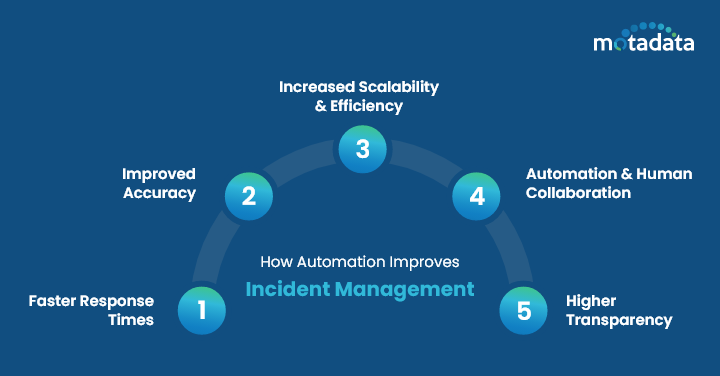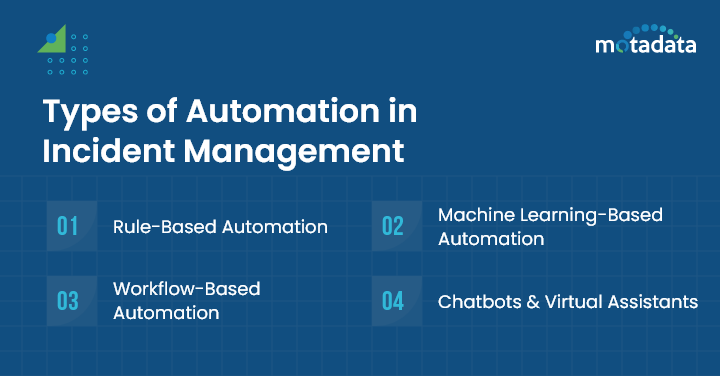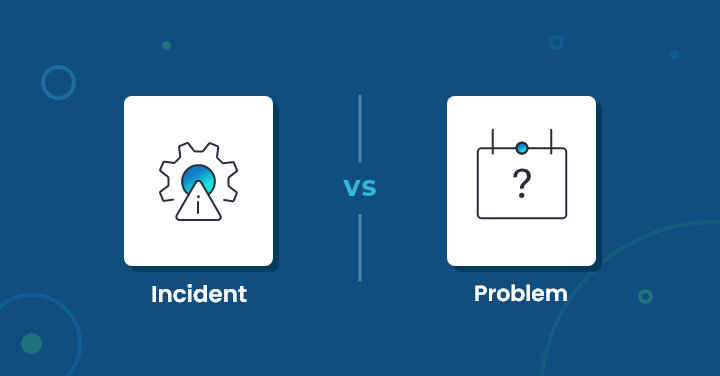Organizations in the 21st century are growing at a staggering rate, expanding their operations over a global network and dealing with more data than ever before.
These widespread operations and processes also mean that there are infinitely more possibilities for businesses to run into problems, have an incident occur, and have to deal with the resulting consequences.
According to a 2021 survey by Kroll, Red Canary, and VMware, nearly 70% of organizations received more than 100 incident alerts daily, while only 20% investigated more than 20 events daily.
An adept incident management system allows companies to detect, evaluate, and swiftly handle critical events that could impact the company in various ways if left unattended.
But as a company grows, incident management can begin to feel like a losing battle.
This is where the rise of automation comes in, helping bolster incident management protocols and improving aspects such as response times and accuracy.
In this blog, we will discuss the growing role of automation in incident management and explore how it can improve response times and accuracy when dealing with emerging incidents.
What is Incident Management?
Incident management comprises a series of instructions that allow companies and organizations to identify, analyze, and resolve incidents that can affect different operational aspects, whether that be loss of operations or negative impacts on services.
It usually involves the following processes:
- Incident Detection
- Incident Logging
- Incident Categorization
- Incident Prioritization
- Incident Response
The Importance of Incident Management in Modern IT Environments
Modern IT environments comprise a host of different components, which eventually become prone to causing errors or being exploited by third parties.
By implementing a thorough incident management process, organizations can go through a system of checks and balances to:
- Detect issues
- Protect against security threats
- Promptly restore their operations in case of an emergency
- Ensuring that their services are impacted in the least disruptive way possible
Introducing Automation in Incident Management
During the incident management process, organizations must deal with many alerts, discrepancies, and abnormalities.
The introduction of automation in incident management allows for easier handling and ultimately improves the system’s efficiency and effectiveness.
Why Automation is Important in Incident Management?
Artificial Intelligence (AI) and Machine Learning (ML) algorithms can be implemented to evaluate and make connections between data from different sources.
This allows incident response and security teams to reduce the time taken to detect and alert to incidents that can negatively impact the organization.
The application of automation in incident management helps teams carry out mundane and repetitive tasks more efficiently, reducing the possibility of introducing human errors into the process.
How Automation Improves Incident Management
The role of automation in incident management is to simplify tasks and ultimately make the process more efficient, helping companies deal with unforeseen events and bounce back quicker from any threats to operations or security.
It improves the incident response plan creation process in the following ways:
1. Faster Response Times
As opposed to human involvement, automation systems and algorithms are able to efficiently sort through red flags and alert to incidents that require further investigation.
Reducing the possibility of human errors and the need for human intervention helps team members respond faster to events and deal with them promptly.
2. Improved Accuracy
Incident management teams often have to deal with false positives among the real alerts, ultimately causing employees to become less responsive in the case of actual alerts that need proper handling.
Automated incident management tools are able to analyze alerts and hand them off to the proper channels in order to determine their legitimacy.
3. Increased Scalability and Efficiency
As organizations scale their operations, they require more adept teams for incident management and response.
This can require the organization to spend a lot more resources on training and support.
With automation, organizations can scale their incident management system according to their needs and achieve lower costs.
Machine learning algorithms can instead learn from their training over time to increase their operational efficiency.
4. Automation and Human Collaboration
As automated incident management systems help reduce the workloads of employees, this leaves them with more valuable time to work on heavier tasks that are better handled by humans instead of being left with automation, such as responding to critical incidents in the best manner.
5. Higher Transparency
The implementation of automated virtual assistants and chatbots can help employees get faster help for any incidents encountered on their end and possibly receive a more detailed account of the problem and the steps taken to resolve it.
Automated algorithms are able to create and manage tickets to ensure further transparency in the incident documentation process.
Types of Automation in Incident Management
According to the operations and functions of an organization, the way automation handles incident management can take on different forms.
Automation in incident management can typically be categorized into the following types:
1. Rule-Based Automation
Rule-based automation in incident management defines specific rules and guidelines to categorize incidents.
Events are classified based on a priority matrix, which helps ensure that certain critical incidents are able to receive the highest order of attention and are resolved in a prompt and systematic manner.
An incident management tool can develop a hierarchy to help incident management teams recognize and carry out incident response processes.
Rule-based automation allows organizations to streamline their incident resolution process and ensure consistency in their incident response efforts.
This type of automation allows for quicker incident detection and prompt handling and resolution, ultimately improving the overall efficiency of incident management.
2. Machine Learning-Based Automation
Machine learning-based automation in incident management uses algorithms that evaluate incident logs and find anomalous flags in the data.
This allows incident management teams to make substantiated decisions. Due to machine learning’s data-driven nature, incident management teams are able to deal with critical events more accurately.
As the ML algorithms continue to evaluate and recognize critical events, they are trained on the outcomes derived from the analysis, and this ultimately improves their ability to identify notable incidents over time.
3. Workflow-Based Automation
Workflow-based automation streamlines and automates the actions and decisions involved in responding to incidents.
This kind of automation establishes preset processes that lead responders through the actions required to handle particular kinds of emergencies.
Tasks, including incident diagnosis, resolution, and communication, are frequently included in these workflows.
Through automation, organizations can guarantee uniformity in incident management and expedite timelines.
A workflow-based automation system can have established procedures for various security incident types, such as malware infections or data breaches.
The automation tool automatically activates the relevant strategy in response to a security warning, directing responders through actions to effectively deal with the incident.
4. Chatbots and Virtual Assistants
Automated virtual assistants and chatbots serve as interfaces that are implemented to provide support for incident handling and gather information in the process.
Machine learning and natural language processing algorithms are used to process natural human speech and analyze it to facilitate the progress of incident handling.
The Best Practices for Automating Incident Management
Although the best way of automating incident management can somewhat vary depending on the scale of operations and organizational objectives, the following practices give a general idea of how such systems can be automated:
Consider a Range of Tools
Consider a range of automated tools and choose the most appropriate selections depending on the needs and situations that can be anticipated.
Depending on the specifications of all anticipated situations, organizations can choose from a variety of automated tools.
For instance, incident detection and network monitoring tools can be implemented to monitor system health and detect any anomalies.
Choosing appropriate tools depends on factors like organizational size, budget, and specific requirements.
Connect Tools with Data Sources
Locate all relevant data sources and establish proper connections with the automated tools.
Effective incident management utilizes data from different sources to detect and handle incidents.
For example, automated tools should be connected to relevant data sources, such as system logs and monitoring tools, to ensure that real-time data on system performance and health is available for incident detection and response.
Proper connections between these data sources and automated tools ensure timely and accurate incident detection and resolution.
Continually Refine System Functioning
Refine the overall system’s functioning to ensure that it can find the root cause of events and provide accurate and reliable feedback in real-world deployment scenarios.
Continual refining of automated incident management functions improves their effectiveness in real-world deployments.
For instance, optimizing algorithms and workflows can help more effectively identify the root cause of incidents and provide reliable feedback.
Machine learning algorithms can be trained on incident data to improve anomaly detection and incident categorization.
Regular testing and validation in simulated and production environments help ensure that the automated system performs reliably and effectively in different deployment scenarios.
Case Study: Emirates Healthcare
Emirates Healthcare required the capability to effectively classify network-related tickets based on their location.
It also required email-to-ticket functionality that worked with the newest Microsoft Exchange servers.
Intelligent automation features were required to automatically route tickets and close those that have already been resolved.
The ITSM solution implemented an ITIL-compliant unified Helpdesk solution that enabled easy incident and service request handling.
While multi-level classification improved ticket organization and prioritizing, the email-to-ticket tool provided effective email support integration. Intelligent workflow automation automated repetitive operations and made ticket routing easier.
The incorporation of HTTPS connections guaranteed safe correspondence between web servers and browsers.
Barcode scan support and asset scanning features utilizing WMI and SSH protocols improved asset management procedures.
This allowed for precise tracking and the streamlining of IT operations.
Conclusion
In order to keep up with the blinding pace of a fierce and competitive market, organizations need to utilize every option in their toolkits to ensure that their operations are robust and are able to bounce back from any malicious attacks or errors.
The role of automation in incident management is to be this fail-safe option, allowing incident handling teams to have some respite from alert fatigue, anomalies, and accidents.
The different types of automated incident management systems are designed to simplify the process, reduce the burden of repetitive and mundane tasks, and provide an actionable path for identifying and resolving critical events.
Motadata is a robust IT operations platform that allows organizations and businesses to maintain a comprehensive visual of their operations, streamlining business operations across the board to address stubborn challenges like slow incident resolution and high operational costs.
Request a demo to learn more about how automated incident management systems can help safeguard, streamline, and strengthen the integrity of your operational infrastructure.
FAQs
Virtual assistants and chatbots are automation tools that allow employees to seek help and support for operational errors and dealing with unforeseen events. For incident management, these serve as data collectors that help move the process forward and accurately identify incidents.
Most components of incident management can be automated to increase their overall efficiency:
- Incident Detection: As the first step in incident handling, machine learning algorithms detect anomalous incidents and train on data to increase their accuracy and efficiency over time.
- Incident Logging: Automation ensures that data is processed and handled in the correct manner, simplifying the second step of logging incidents.
- Incident Categorization: Automated tools can categorize incidents and give top priority to critical events, allowing incident management teams to deal with more disruptive situations promptly.
- Automated Incident Response: Automation can allow incident management teams to run similar protocols and processes for recurring events.
With the overwhelming pace of today’s markets, traditional incident management is unable to keep up with the number of events and errors that require identification and resolution.
Automation helps reduce repetitive tasks and generally lightens the workloads of employees, allowing them to focus on the more complex aspects of incident handling and subsequent resolution.
The initial role of automation in incident management is to gather data in real-time and categorize incidents based on criticality and other pre-determined criteria.
The automation of such tasks gives incident management and response teams a little breathing room, ensuring that they are able to focus on resolving any possible technical issue and reducing the damage caused by any critical events.








